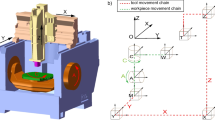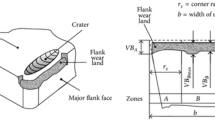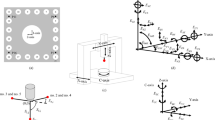Abstract
Most computer numerically controlled (CNC) machine tools with turning capability use turning tools with clamped inserts due to their high precision and ease of replacement. However, although the handles of the turning tools are marked with their specification details, such labels do not appear on the inserts themselves and, thus, often lead to misplacement and installation of incorrect inserts. Accordingly, many researchers have proposed imaging systems based on scanners, single cameras, or microscopes for the automatic measurement and identification of inserts. However, such systems require that the inserts be unloaded from the turning tool and positioned precisely in front of the imaging system. Consequently, online measurement is impossible. This study thus proposes a three-dimensional (3D) vision system capable of identifying inserts in situ based on 3D measurements. Specifications such as insert angles, edge lengths, and nose radii of each insert were identified. The feasibility of the proposed system is demonstrated by identifying the specifications of nine types of insert. The experimental results show that the system achieves an average recognition rate of 98.89% for insert angles, 95.56% for cutting edge lengths, and 92.22% for nose radii.
Similar content being viewed by others
References
Ruiz ARJ, Rosas JG, Granja FS, Honorato JCP, Taboada JJE, Serrano VM et al (2009) A real-time tool positioning sensor for machine-tools. Sensors 9:7622–7647
Tian X, Zhang K, Yamazaki A, Hansel A (2010) A study on three-dimensional vision system for machining setup verification. Robot Comput Integr Manuf 26:46–55
Ahmad R, Tichadou S, Hascoet J-Y (2012) New computer vision based snakes and ladders algorithm for the safe trajectory of two axis CNC machines. Comput Aided Des 44:355–366
Zhang X, Tsang W, Tian X, Yamazaki K, Mori M (2008) Automatic segmentation of the apparent contour for 3D modeling of cutting tools from single view in Advances in Visual Computing, ed: Springer, pp. 772–781
Chian G, Ratnam M (2011) Determination of tool nose radii of cutting inserts using machine vision. Sens Rev 31:127–137
Lim T, Ratnam M (2012) Edge detection and measurement of nose radii of cutting tool inserts from scanned 2-D images. Opt Lasers Eng 50:1628–1642
Diniz AE, Micaroni R (2002) Cutting conditions for finish turning process aiming: the use of dry cutting. Int J Mach Tools Manuf 42:899–904
Chou YK, Song H (2004) Tool nose radius effects on finish hard turning. J Mater Process Technol 148:259–268
Nath C, Rahman M, Neo KS (2009) A study on the effect of tool nose radius in ultrasonic elliptical vibration cutting of tungsten carbide. J Mater Process Technol 209:5830–5836
Forsyth DA, Ponce J (2002) Computer vision: a modern approach, ed: prentice hall professional technical reference
Trucco E, Verri A (1998) Introductory techniques for 3-D computer vision, vol. 201, ed: Prentice Hall Englewood Cliffs
Tsai RY (1987) A versatile camera calibration technique for high-accuracy 3D machine vision metrology using off-the-shelf TV cameras and lenses. IEEE Trans Robot Autom 3:323–344
Longuet-Higgins H (1987) A computer algorithm for reconstructing a scene from two projections Readings in Computer Vision: Issues, Problems, Principles, and Paradigms, MA Fischler and O. Firschein, eds, pp. 61–62
Hartley R, Zisserman A (2000) Multiple view geometry in computer vision, Cambridge University Press, vol. 2
Zhang Z (1998) Determining the epipolar geometry and its uncertainty: a review. Int J Comput Vis 27:161–195
Fusiello A, Trucco E, Verri A (2000) A compact algorithm for rectification of stereo pairs. Mach Vis Appl 12:16–22
Derpanis KG (2005) Relationship between the sum of squared difference (SSD) and cross correlation for template matching. York University press
Wong S, Vassiliadis S, Cotofana S (2002) A sum of absolute differences implementation in FPGA hardware in Proceedings of 28th Euromicro conference, , pp. 183–188
Zhang Z (2000) A flexible new technique for camera calibration. IEEE Trans Pattern Anal Mach Intell 22:1330–1334
Bouguet J-Y (2004) Camera calibration toolbox for matlab
Mook W, Shahabi H, Ratnam M (2009) Measurement of nose radius wear in turning tools from a single 2D image using machine vision. Int J Adv Manuf Technol 43:217–225
Gonzalez RC, Woods RE, Eddins SL (2004) Digital image processing using MATLAB: Pearson education, India
Demigny D, Lorca FG, Kessal L (1995) Evaluation of edge detectors performances with a discrete expression of Canny's criteria in Proceedings of International Conference on Image Processing, pp. 169–172
Duda RO, Hart PE (1972) Use of the Hough transformation to detect lines and curves in pictures. Commun ACM 15:11–15
Acknowledgments
The authors gratefully acknowledge the financial support provided to this study by the Ministry of Science and Technology, Taiwan, R.O.C., under Grant No. MOST 103-2221-E-194-042.
Author information
Authors and Affiliations
Corresponding author
Rights and permissions
About this article
Cite this article
Ping, GH., Chien, JH. & Chiang, PJ. Verification of turning insert specifications through three-dimensional vision system. Int J Adv Manuf Technol 96, 3391–3401 (2018). https://doi.org/10.1007/s00170-018-1805-4
Received:
Accepted:
Published:
Issue Date:
DOI: https://doi.org/10.1007/s00170-018-1805-4




